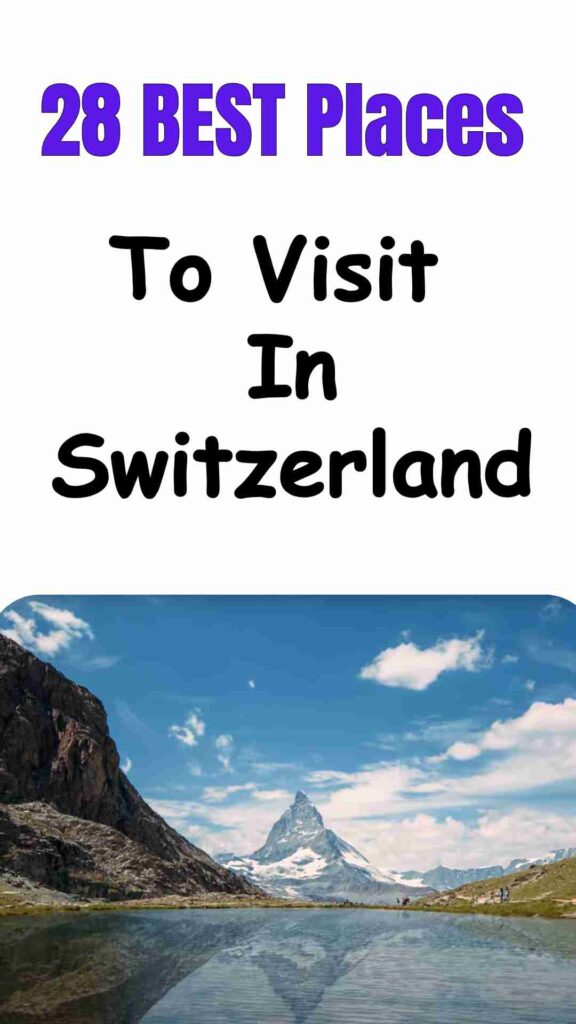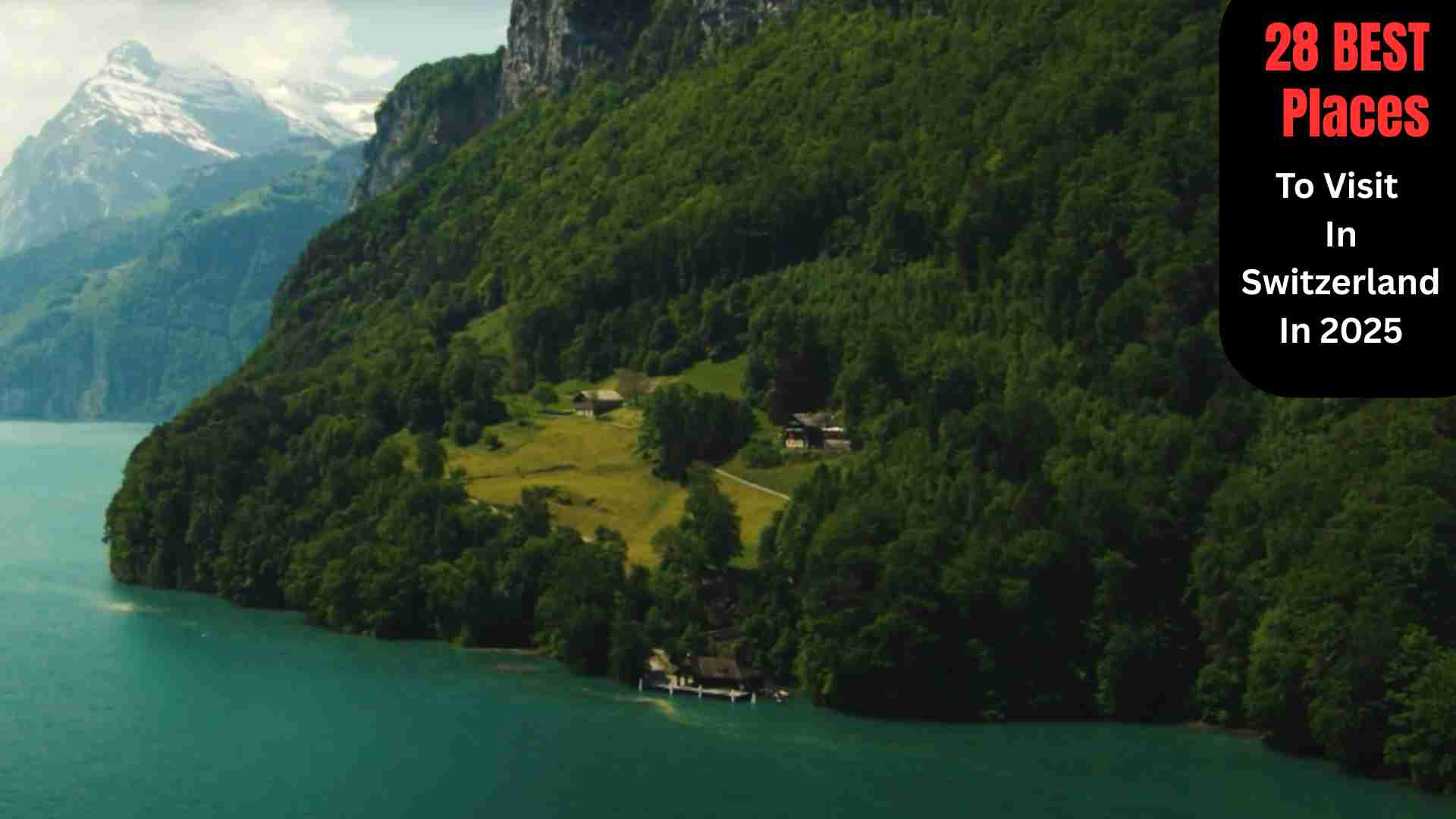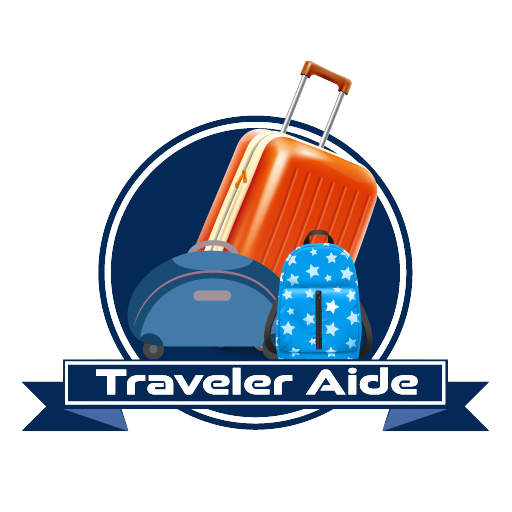If you’re dreaming about snow-capped mountains, charming alpine villages, and crystal-clear lakes, then Switzerland should be high on your 2025 travel list. This beautiful country isn’t just about chocolate and cheese (though yes, those are excellent too). From vibrant cities to remote hiking trails, Switzerland is packed with places that feel straight out of a storybook.
Planning a trip here can be overwhelming—with so many postcard-perfect spots, where do you even begin? Don’t worry. I’ve rounded up the 28 BEST places to visit in Switzerland in 2025 based on real experiences, local insights, and what’s trending this year. Whether you’re a first-timer or a returning traveler, there’s something new and exciting waiting for you.
Time to uncover the first few treasures!
1. Zermatt – For Views of the Mighty Matterhorn
If there’s one image that screams “Switzerland,” it’s the sharp peak of the Matterhorn towering over the quiet town of Zermatt. This place is a magnet for hikers, skiers, and photographers alike. In winter, the slopes are perfect for all skill levels. In summer, the hiking trails give you unbeatable alpine views.
What makes Zermatt extra special? It’s a car-free town, which means the air is clean and you can actually hear the mountains. Take the Gornergrat Railway for panoramic views, or hop on the Matterhorn Glacier Paradise cable car—Europe’s highest. Just remember: it’s not cheap here, but the experience is worth every franc.
2. Lauterbrunnen – The Valley of 72 Waterfalls
Lauterbrunnen feels like it fell out of a fairy tale. Seriously. Imagine a narrow valley flanked by steep cliffs, dotted with wooden chalets, and thundered by waterfalls—72 of them, to be exact.

The most iconic is Staubbach Falls, which drops 300 meters right next to the village. But the hidden Trümmelbach Falls, tucked inside a mountain, are just as jaw-dropping.
Come in spring or early summer when the snow melts and the falls are at full force. Bonus: Lauterbrunnen is also your launchpad to explore Wengen, Mürren, and even the Jungfraujoch—Europe’s highest train station.
3. Lucerne – History, Lakes, and Mountains
Lucerne is one of those cities that balances beauty with culture. You get a lovely old town filled with painted facades and cobbled streets, all set against the deep-blue Lake Lucerne and snowy Mt. Pilatus.
Don’t miss walking across the Chapel Bridge, a 14th-century wooden footbridge lined with historic paintings. Then there’s the Lion Monument, carved into a cliffside, honoring Swiss Guards who died in the French Revolution—it’s surprisingly moving.
For something different, take the world’s steepest cogwheel railway up to Mount Pilatus, or hop on a paddle steamer to cruise the lake. It’s a city that feels like a vacation and a history lesson at the same time.
4. Bern – A Quiet Capital Full of Surprises
You might not expect much from Switzerland’s capital—it’s quieter than Zurich and less flashy than Geneva—but Bern has a quiet charm that sneaks up on you.
The Old Town is a UNESCO World Heritage Site, with six kilometers of covered arcades perfect for rainy days. The Zytglogge, an elaborate medieval clock tower, still puts on a show every hour. And if you’re there in summer, join the locals swimming down the Aare River—yes, really.
Tip: Bern is great for slow travel. Spend time at Rosengarten for views of the city and the Alps beyond, or sip coffee by the Bundeshaus (parliament building). You’ll feel like you’re part of the city, not just a visitor.
5. Interlaken – The Adventure Capital of Switzerland
If you’re the type who likes a shot of adrenaline with your mountain views, Interlaken is your playground. Sandwiched between Lake Thun and Lake Brienz, and surrounded by peaks like the Eiger, Mönch, and Jungfrau, this town is all about action.
Paragliding, canyoning, skydiving, bungee jumping—you name it. But even if you’re not a daredevil, there’s plenty to enjoy: scenic lake cruises, peaceful strolls along the Höhematte Park, or taking the Harder Kulm funicular for jaw-dropping views.
In 2025, eco-tourism is growing fast here, with more electric boats and green hotels popping up. It’s a great time to go if you’re into sustainable travel.
6. Grindelwald – Alpine Charm with Serious Scenery
Nestled in the Bernese Oberland, Grindelwald is a mountain village with charm to spare. It’s less crowded than Interlaken but just as stunning—maybe more. You’re surrounded by giants like the Eiger and Wetterhorn, and the views from town are enough to make your jaw drop.
In 2025, the Eiger Express cableway is still a game-changer, getting you to the Jungfraujoch much faster. But don’t skip the First Cliff Walk, a metal pathway hanging off a cliff with dramatic panoramas. It’s terrifying. And amazing.
If you love hikes with a reward, try the Bachalpsee trail. A short trek leads you to a glassy alpine lake that mirrors the peaks behind it. Perfect for sunrise or a calm picnic.
7. Geneva – Global, Green, and Gorgeous
Geneva often gets labeled as “serious” because it’s home to the UN and Red Cross. But look beyond the politics, and you’ll find a city full of quiet beauty and lakeside calm.
Start at Lake Geneva. The Jet d’Eau fountain shoots water 140 meters into the air—it’s kind of ridiculous, but also fun. Stroll through the Old Town, visit St. Pierre Cathedral, and stop at a café for fondue (yes, it’s totally acceptable even in summer).
In 2025, Geneva’s urban greenery movement is booming. New bike lanes, car-free zones, and eco-events are making the city more walkable and welcoming than ever.
8. Montreux – Jazz and Riviera Vibes
If you’re visiting in July, you have to check out the Montreux Jazz Festival. Even if you’re not into jazz, the atmosphere along Lake Geneva’s edge is electric.
Montreux sits on what feels like Switzerland’s Riviera—mild climate, palm trees, flower-lined promenades. But there’s also Chillon Castle, one of the most photogenic spots in the country, perched on the water like a fantasy movie set.
Bonus tip: Take the scenic GoldenPass Line from Montreux to Lucerne. It’s an underrated ride with epic lake and mountain views.
9. Appenzell – Quirky, Colorful, and Quiet
Appenzell feels like a secret. No massive tour groups, no crazy crowds—just colorful houses, green hills, and a culture that’s proudly different.
This is where traditional Swiss customs are still alive. You might catch yodeling, open-air cheese markets, or even barefoot farmers in traditional dress. It’s charming without trying too hard.
For hikers, the Ebenalp and Seealpsee trails are incredible. The Äscher cliff restaurant, literally built into the rock face, is a must-stop—even if it’s just for a coffee and photo.
10. Zurich – More Than Just a Finance Hub
Zurich is often dismissed as just a business city, but that’s unfair. Yes, it’s clean, efficient, and yes, expensive—but it also has soul if you know where to look.
In 2025, the Kreis 5 district is the place to be. It’s edgy, artsy, and full of converted warehouses turned galleries, microbreweries, and food halls. Take a walk along the Limmat River, rent a paddleboard on Lake Zurich, or grab brunch at a café in Niederdorf.
The blend of historic and modern here is real. And if you’re into nightlife, Zurich’s bar scene is surprisingly good—just be ready for Swiss prices.
11. Lugano – The Italian-Swiss Blend
Lugano is where Switzerland loosens its tie. You’ll hear Italian, smell espresso in the air, and see palms swaying by the lake. It feels like the Mediterranean with a Swiss twist.
The Piazza della Riforma is a great place to people-watch with a cappuccino. Then take a funicular up Monte Brè or Monte San Salvatore for dreamy lake views.
In 2025, Lugano is gaining attention for its eco-luxury hotels and slow food scene. It’s a perfect stop if you want a taste of “la dolce vita” without leaving Switzerland.
12. Aletsch Glacier – Switzerland’s Icy Giant
Want to see a UNESCO-listed glacier before it changes forever? Head to the Aletsch Glacier, the longest in the Alps. It’s over 20 kilometers long and absolutely awe-inspiring.
Base yourself in Fiesch or Bettmeralp, both quieter alternatives to the more touristy alpine towns. The Eggishorn viewpoint gives you a sweeping look at the glacier—especially magical at sunrise.
Glacier walks are available with local guides, and in 2025, there’s growing focus on climate education here. Visiting Aletsch isn’t just a trip—it’s a reminder of what we stand to lose.
13. St. Moritz – Glamour in the Snow
St. Moritz is the kind of place where luxury meets the mountains. Think fur-lined jackets, designer boutiques, and frozen lakes turned into polo fields. But beyond the glitz, it’s genuinely beautiful.
The Upper Engadin Valley offers world-class skiing in winter and dreamy hiking in summer. In 2025, St. Moritz continues to lead with eco-conscious luxury—expect hybrid transport, gourmet plant-based menus, and sustainable ski resorts.
Even if you’re not staying in a 5-star hotel, riding the Bernina Express here is worth it. The views over the Lago Bianco and the Alps are next-level.
14. Gstaad – Alpine Chic Without the Crowds
Gstaad is like St. Moritz’s cool, quiet cousin. It still attracts the rich and famous, but it does so with more wooden chalets than flashy buildings.
In summer, the meadows around Gstaad are green and full of wildflowers. In winter, it’s all about cozy vibes, great skiing, and cheese fondue in mountain huts.
Don’t miss the Wispile panoramic hike or the Glacier 3000 cable car, where you can walk the Peak Walk by Tissot—a suspension bridge between two mountain peaks. It’s way less crowded than you’d expect for such a thrill.
15. Schaffhausen – The Home of Europe’s Largest Waterfall
Schaffhausen is often skipped—and that’s a shame. This medieval town in northern Switzerland is home to Rhine Falls, the largest waterfall in Europe. It’s not super tall, but it is incredibly powerful and loud in the best way.
You can take a boat right up to the falls or walk over the Laufen Castle bridge for overhead views. Schaffhausen itself is also cute, with colorful bay windows, narrow lanes, and wine from the surrounding Blauburgunderland region.
Great for a day trip from Zurich or as a quieter overnight stop if you want to slow down.
16. Sion – Castles, Wine, and Sun
Located in the heart of the Valais region, Sion is one of the sunniest places in Switzerland. It’s also one of the oldest towns, with a relaxed, earthy feel that’s hard to find in the more polished tourist hubs.
The twin castles—Valère and Tourbillon—dominate the skyline. You can hike up to both for fantastic valley views. And if you’re into wine, this is your place. Sion is surrounded by vineyards producing some of Switzerland’s best whites and reds.
In 2025, wine tourism is booming here. Look for small, family-run tasting tours that often include homemade cheese and dried meats. It’s rustic in the best way.
17. Davos – More Than Just a Summit City
Most people know Davos for the World Economic Forum, but it’s also a top-notch destination for outdoors lovers. It’s the highest city in Europe and has a massive network of hiking and biking trails.
The Parsenn area offers great skiing, and in summer, the Lake Davos area is popular for windsurfing, paddleboarding, and picnicking. The nearby village of Klosters offers a more charming, laid-back vibe if you prefer chalet over conference center.
Davos is investing in climate-neutral tourism in 2025—think solar-powered lifts and car-free days—so it’s a great pick for sustainable travelers.
18. Thun – The Less-Touristy Lake Town
Want the beauty of Interlaken without the crowd? Head to Thun, perched at the opposite end of Lake Thun. It’s got a majestic castle, cozy old town, and stunning views of the Bernese Alps.
What makes Thun special is how real it feels. You’ll find locals shopping at open-air markets and students lounging along the Aare River. Don’t miss a walk across the wooden covered bridges or a boat ride on the lake for peaceful mountain scenery.
In 2025, Thun is quietly becoming a creative hub, with more art galleries, indie shops, and cultural events popping up around town.
19. Bellinzona – Castles in the South
Tucked in the Italian-speaking canton of Ticino, Bellinzona feels like a medieval time capsule. It’s known for its three UNESCO-listed castles—Castelgrande, Montebello, and Sasso Corbaro—all set against green hills and stone walls.
It’s a small city, but it packs a punch. You can explore all three castles in a day and still have time to enjoy risotto and local Merlot in a sunlit piazza.
Because Bellinzona is less known internationally, you’ll find more local flavor and fewer crowds. It’s a great stop if you’re traveling between Lugano and northern Italy.


